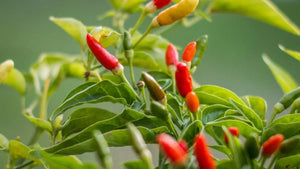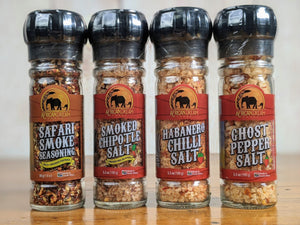The Fiery History of Peri-Peri Sauce: From Africa to Global Kitchens
Sep 24, 2025
Can You Take the Heat? Exploring the World of Peri-Peri
For those who like to spice things up, it’s time to expand your horizons beyond Tabasco and Sriracha and learn about the history of Peri-Peri.
What Is Peri-Peri?
Peri-Peri — also spelled piri-piri or pili-pili — is more than just a spicy condiment. It’s a fiery, flavorful sauce made from African bird’s eye chilli peppers. Known for its heat and earthy depth, Peri-Peri also carries subtle sweetness and tang, making it a versatile and complex addition to a variety of dishes.
Want to taste it for yourself? Try our Ghost Peri-Peri Sauce — a bold, balanced blend with medium heat and big flavor.

The History of Peri-Peri
“Peri-Peri” is a very hot sauce made with chilli peppers and, from a taste point of view, it brings plenty of fire, but also an earthiness and hint of sweetness.
The history of Peri-Peri is a controversial one. It is believed that it was created by Portuguese explorers in Mozambique in the 15th century, who discovered the African bird’s eye chilli pepper and made a marinade with garlic, red wine vinegar, paprika, and other European ingredients. It then expanded to other Portuguese territories under the spelling of “piri-piri.” The nam
e “peri-peri” is derived from Swahili. ‘Piri-piri’ means “pepper-pepper.” It has several iterations including ‘pili-pili’ and ‘peri-peri’ — but the amazing flavor is the same.
If you’re curious about how Peri-Peri compares to other hot sauces, check out our guide to choosing the right chili sauce for your spice tolerance.
African Origins and Global Spread
Like all chilli peppers, Peri-Peri is descended from plants native to the Americas, but it has grown in the wild in Africa for centuries. Today, it’s cultivated commercially in countries such as Zambia, Uganda, Malawi, Zimbabwe, and Rwanda.
Peri-Peri is more than just a kitchen staple — it plays a role in agriculture and even the pharmaceutical industry. It grows mainly in Malawi, Zambia, South Africa, Ghana, Nigeria, Zimbabwe, Mozambique, and Portugal. The chillies are cultivated for both commercial food processing and medical applications, particularly for their capsaicin content.
Interestingly, Peri-Peri is sometimes used to support treatments for conditions like schizophrenia, anxiety, and mania — though more studies are needed to confirm clinical benefits. This study on capsaicin provides insight into its potential uses beyond food.
How Hot Is Peri-Peri?
Depending on the crop, these chillies can register up to 175,000 Scoville Heat Units (SHU) — placing them well above jalapeños and just under habaneros on the spice scale.
But don’t worry: not all Peri-Peri sauces are this intense. For example, our Lemon & Garlic Peri-Peri Sauce offers a gentler heat with zesty citrus notes that even mild spice lovers can enjoy.

African Dream Foods’ Approach to Peri-Peri
African Dream Foods Peri-Peri sauces aren’t quite that hot, but the unique flavor provides an exotic dining experience that mimics the rich history of Peri-Peri.
Crafted in South Africa, these sauces balance heat with complexity — featuring layers of citrus, garlic, and spice. They’re designed to enhance, not overpower, your food. Explore our full Peri-Peri sauce collection to find your perfect match.
What to Eat with Peri-Peri Sauce
Peri-Peri pairs quite well with chicken — particularly when you barbecue or roast it — as well as with barbecue shrimp. A popular South African snack is roasted cashews with Peri-Peri spice.
If you're looking for inspiration, try our recipe for Grilled Hotdogs with Ghost Peri-Peri Pineapple Salsa — it’s a crowd-pleasing twist on a cookout classic.

Frequently Asked Questions About Peri-Peri
Where did peri-peri sauce originate?
Peri-peri sauce originated in Southern Africa, where Portuguese settlers discovered the African bird’s eye chili and blended it with garlic, citrus, and spices. It quickly became a staple in both African and Portuguese cuisine.
Is peri-peri the same as piri-piri?
Yes, peri-peri and piri-piri refer to the same chili pepper and sauce. The spelling differs depending on the region, but both describe a fiery sauce made from bird’s eye chilies, garlic, lemon, and oil.
Why is peri-peri sauce so popular?
Peri-peri sauce is loved for its unique balance of heat, tang, and flavor. It became internationally popular through restaurant chains like Nando’s and is now used worldwide to add spice to chicken, seafood, and vegetables.
What foods go well with peri-peri sauce?
Peri-peri sauce pairs perfectly with grilled chicken, seafood, roasted vegetables, sandwiches, and even fries. Its versatile heat and zesty flavor make it a favorite for marinades, dips, and finishing sauces.
How hot is peri-peri sauce?
Peri-peri chilies can measure up to 175,000 SHU, hotter than jalapeños but milder than habaneros. Not all sauces are that fiery — blends like Lemon & Garlic Peri-Peri are much gentler.
What’s the difference between peri-peri and other chili sauces?
Unlike many chili sauces that focus purely on heat, peri-peri balances spiciness with tangy citrus, garlic, and earthy depth. This makes it different from vinegar-forward sauces like Tabasco or sweeter sauces like sriracha.
Why Peri-Peri Is Here to Stay
With bold flavors and a global story that spans continents, Peri-Peri has cemented its place in modern kitchens. Its versatility, heat, and rich heritage make it a favorite among food lovers, from home cooks to professional chefs.




